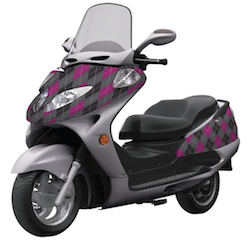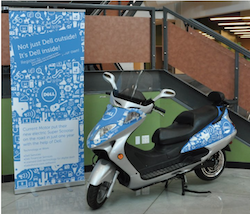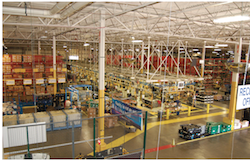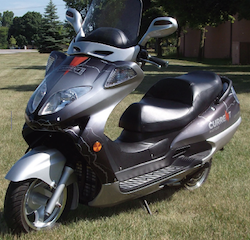Anatomy of a Startup: Current Motor and the Super Scooter Electric Motorcycle Hit the Road
 Current Motor’s Super Scooter electric motorcycle, which began shipping last February, is in the forefront of the green vehicle revolution. It combines the performance of more expensive electric motorcycles with a lower purchase price and costs less than two cents a mile to operate.
Current Motor’s Super Scooter electric motorcycle, which began shipping last February, is in the forefront of the green vehicle revolution. It combines the performance of more expensive electric motorcycles with a lower purchase price and costs less than two cents a mile to operate.
The snappy little EV (electric vehicle), made in Michigan, has a battery range of 50 miles – more than enough juice for urban driving; a top speed of over 65 mph; and a sticker price of $9,995. It also comes with a super smart dashboard powered by Dell that features WIFI and GPS, and a variety of smartphone apps such as the ability to check and schedule charging; measure your CO2 savings; and conduct on board fleet management.
The integrated smartphone technology is a Dell-powered Android device that collects and transmits data back to the Current Motor cloud IT infrastructure, allowing the company to detect rider preferences and bike performance as well as feed the data into its customer service system to perform remote diagnostics.
 The Super Scooter can be personalized or branded with custom wraps – customers design their own vehicle online.
The Super Scooter can be personalized or branded with custom wraps – customers design their own vehicle online.
The company is headquartered in Ann Arbor, Mich. with service centers and showrooms planned to open in Chicago and Brazil.
The saga of Current Motor is also a lesson in how to launch a manufacturing startup. It all started, as these kind of ventures often do, with some guys in a garage having fun with their favorite hobby – in this case motorcycle and electric scooter racing. It didn’t hurt that two of the co-founders, John Harding and Erik Kauppi, are ex-Ford engineers and EV pioneers, and another founder, Terry Richards, has 30 years of EV development experience at VW, Chrysler and Tata under his belt.
When Lauren Flanagan, a Michigan-based former software entrepreneur turned investor, saw the prototype, she liked the concept. In fact, as the managing partner of BELL Capital LP, she liked it enough to become one of the company’s first investors and subsequently Current Motor’s executive chairman. (BELLE Capital is an early stage angel fund that invests in women-led companies in Michigan and the Midwest.)
 The scooters are being manufactured at another women-owned enterprise – Dakkota Integrated Systems, a leading automotive flex manufacture in Lansing, Mich. that builds the machines JIT and ships directly to the customer.
The scooters are being manufactured at another women-owned enterprise – Dakkota Integrated Systems, a leading automotive flex manufacture in Lansing, Mich. that builds the machines JIT and ships directly to the customer.
Lessons Learned
The various steps that transformed Current Motor from a research and development lab into a fully-functioning commercial enterprise with product going out the door is chronicled in a case study on the Dell web site. You can download a PDF here.
But the anatomy of a startup is not the only lesson to be gleaned from the Current Motor odyssey. For example, in several instances, the engineers and management of the company have sidestepped the dreaded “Not Invented Here” syndrome. They turned to existing solutions and expertise to speed up time to market and build the internal infrastructure needed to handle the demanding IT requirements that form the backbone of company operations and customer interaction.
In the first instance, the engineers decided to take a systems integration approach, buying many of the scooter’s components off-the-shelf. However, the all-important power train and the sophisticated electronics and software are proprietary – both constitute major differentiators for the Super Scooter in this rapidly growing new market. The company has developed significant intellectual property around the bike control unit and motor as well as developing a proprietary battery management system, assembly art, and copyrighted software.
The other anti-NIH initiative instituted by the company was to seek outside help to build Current Motor’s all-important IT infrastructure. Flanagan attended Dell’s annual Dell Women’s Entrepreneur Network event and was so impressed that she decided to bring Dell on board to develop and handle the IT implementation, including cloud services and the integration of Salesforce software.
“It’s like having a CIO in a box,” she says.
By turning to Dell for IT services, the company avoided the up-front expense of hiring a CIO and supporting staff, helping to keep costs down and speeding up the process of developing the customer service systems and analytics. Flanagan says the Dell team accomplished in 30 days what she would have expected to take six months.
“The integration with Salesforce is major,” she continues. “I’ve done this with other companies and it’s always been so painful. Dell getting the system up and running in 30 days is huge.”
 This was not your usual Salesforce integration, Flanagan explains. This is big data. It includes all data on the customer and the individual scooter, plus all the information being generated by the smart dashboard that is sent into the service cloud. This includes a wide range of operational data such as the temperature of the battery cells and the time and frequency of charging – all generated in real time and delivered to the service cloud via the on-board WIFI system. As more and more Super Scooters hit the road and begin passing data to the cloud, Current Motor is rapidly moving deeply into the realm of big data. Part of Dell’s mission is to help the company send and store data efficiently and apply the latest analytic techniques for customer service, product development, and marketing.
This was not your usual Salesforce integration, Flanagan explains. This is big data. It includes all data on the customer and the individual scooter, plus all the information being generated by the smart dashboard that is sent into the service cloud. This includes a wide range of operational data such as the temperature of the battery cells and the time and frequency of charging – all generated in real time and delivered to the service cloud via the on-board WIFI system. As more and more Super Scooters hit the road and begin passing data to the cloud, Current Motor is rapidly moving deeply into the realm of big data. Part of Dell’s mission is to help the company send and store data efficiently and apply the latest analytic techniques for customer service, product development, and marketing.
To handle the company’s rapid growth, the Dell IT team has installed scalable PowerEdge servers virtualized with Microsoft Hyper-V2008 R2 server. The servers, along with seven terabytes of Dell EqualLogic PS4100 storage sit in a self-contained “data center” in a rack connected with Dell Force 10 SAN switches. Employees use Dell client desktops, laptops and tablet computers.
Dell provided even more than hardware, IT services and consulting – it helped with the financing as well. Dell Financial Services put together an attractive lease-package for Current Motor. As Flanagan says in the case study, “We didn’t have to use our capital for sales, marketing and R&D. We can grow faster this way.”
But Flanagan’s vision extends beyond creating a profitable and growing Current Motor. She notes, “Women are starting three out of five new companies, but are getting less than eight percent of the early stage capital – and women also control 50 percent of that capital. I always say, ‘We’re the solution to our own problems.’ If we can get some of the money that’s on the sidelines invested in early stage companies, women will naturally be involved and know other women starting businesses – so the deal flow problem and some of the money problems will be solved.”
She adds, “Part of my vision is to grow the early stage landscape ecosystem by getting more successful executives – both men and women – to put not only their money into early stage companies, but also their human capital, their knowledge and expertise. For example, our experience starting up Current Motor and our relationship with Dell can be replicated by other start-ups and help invigorate the economy in the bargain.”










